|


























| |
In “Four Perfect Days in Yokohama,”
Glenn described the Kaikō Promenade as follows:
Many of the interesting harborside
areas are linked by a walking tour called “Kaikō no Michi,” shown with a red
dotted line on your map, and also signposted as the “Yamashita Rinkō-sen
Promenade.” It follows the tracks of a discontinued freight rail line from
Yamashita Park past Kaiko Hiroba Square, the spot where Commodore Perry
signed the Treaty of Kanagawa which opened Japan from isolation 150 years
ago, the Archives of History (a small museum), the Customs tower, and the
Aka-Renga red brick warehouses (built in the 1910s), from which you can
walk to the Minato Mirai (Harbor of the Future) area. It includes
several large complexes for shopping and eating, including World Porters,
Queen’s Square, and Landmark Plaza (beneath the tallest
building in Japan, 296-meter Landmark Tower), as well as an amusement park
with the world’s second-tallest Ferris wheel (simultaneously the world’s
largest clock) and a sailing ship floating in wet-dock, the Nippon Maru,
next to the Maritime Museum. These are all connected to each other and to
Sakuragi-chō station on the JR train line.
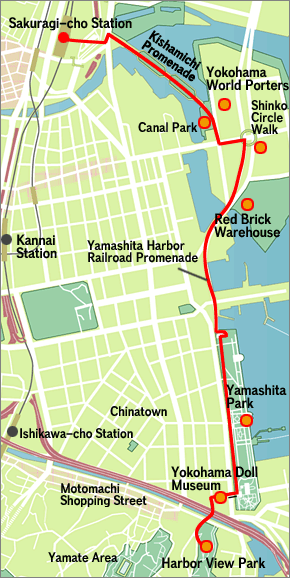 This
map shows the entire route of the Kaikō Promenade. This
map shows the entire route of the Kaikō Promenade.
We ultimately walked most of the length
of the promenade, covering it in stages over several days. The center portion,
through Yamashita Park, we saw many times.
West End
We tackled the western (Rinkō
Line) portion of the promenade on Friday, June 4. Although we didn’t have time to really
explore any of the sights along the way, we did see many of the ones Glenn
mentioned. And, as you can see, it was a continuing challenge to get the
definitive photo of the Ferris wheel clock.
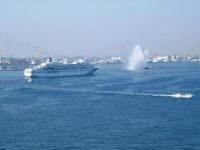 As
we approached the west end of Yamashita Park to begin the trek, I captured this
view of the harbor: In the foreground the Sea Bass shuttle heads for the
Yamashita Park terminus. In the background, a fireboat salutes a cruise ship
departing from the passenger terminal. As
we approached the west end of Yamashita Park to begin the trek, I captured this
view of the harbor: In the foreground the Sea Bass shuttle heads for the
Yamashita Park terminus. In the background, a fireboat salutes a cruise ship
departing from the passenger terminal.
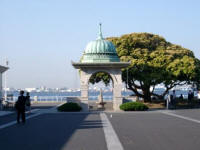 The
“India Water Tower” or Indian water fountain, presented by an association
of East Indians living in Japan, at the west end of
Yamashita Park. The promenade begins up a flight of stairs to the left (out of
the picture). The
“India Water Tower” or Indian water fountain, presented by an association
of East Indians living in Japan, at the west end of
Yamashita Park. The promenade begins up a flight of stairs to the left (out of
the picture).
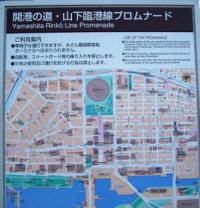 A
placard showing the route of Rinkō Line portion of the promenade and setting forth the “rules”: “The
use of bicycles, skateboards and similar devices is prohibited on the
promenade,” and “The use of fire, and other acts that interfere with the passage
of pedestrians on the promenade are prohibited.” The sign also announces that,
while the entire length of the promenade is wheelchair-accessible, “there are no
facilities to access the Yokohama International Passenger Terminal from the
promenade by wheel chair.” A
placard showing the route of Rinkō Line portion of the promenade and setting forth the “rules”: “The
use of bicycles, skateboards and similar devices is prohibited on the
promenade,” and “The use of fire, and other acts that interfere with the passage
of pedestrians on the promenade are prohibited.” The sign also announces that,
while the entire length of the promenade is wheelchair-accessible, “there are no
facilities to access the Yokohama International Passenger Terminal from the
promenade by wheel chair.”
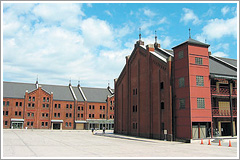 The
Red Brick Warehouses, or Aka-Renga. These warehouses, built by the federal
government between 1911 and 1913, have withstood the ravages of a major
earthquake and the Second World War. Over the years, as shipping operations
dispersed to other ports, these warehouses were slowly forgotten. They were
bought by Yokohama City in 1992, and were refurbished using the latest in
renovation technology and earthquake-proof reinforcements while preserving the
historically important physical structures. It took a while, but the Red Brick
Warehouse Park was reopened in 2002. The smaller Building #1 is mainly for
special events: it contains a large theater on the third floor and several
smaller exhibit spaces on the second floor, and a few shops on the first floor.
The larger Building #2 has three floors of specialty shops, cafés,
and restaurants. The open space between the two warehouses is maintained as a
park, and in the evening, the two buildings are beautifully illuminated. The
Red Brick Warehouses, or Aka-Renga. These warehouses, built by the federal
government between 1911 and 1913, have withstood the ravages of a major
earthquake and the Second World War. Over the years, as shipping operations
dispersed to other ports, these warehouses were slowly forgotten. They were
bought by Yokohama City in 1992, and were refurbished using the latest in
renovation technology and earthquake-proof reinforcements while preserving the
historically important physical structures. It took a while, but the Red Brick
Warehouse Park was reopened in 2002. The smaller Building #1 is mainly for
special events: it contains a large theater on the third floor and several
smaller exhibit spaces on the second floor, and a few shops on the first floor.
The larger Building #2 has three floors of specialty shops, cafés,
and restaurants. The open space between the two warehouses is maintained as a
park, and in the evening, the two buildings are beautifully illuminated.
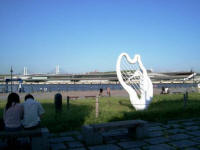 This
fanciful sculpture stands on the waterfront behind the Aka-Renga complex. In the
background is the Yokohama International Passenger Terminal. This
fanciful sculpture stands on the waterfront behind the Aka-Renga complex. In the
background is the Yokohama International Passenger Terminal.
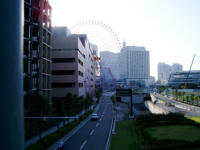 First
view of the Cosmo World Ferris wheel/clock (note the time: 5:16 p.m.). The photo
was probably taken from the Shinkō Circle Walk, an elevated circular walkway
above the intersection of Kokusai Odori Boulevard and Bashamichi Avenue. First
view of the Cosmo World Ferris wheel/clock (note the time: 5:16 p.m.). The photo
was probably taken from the Shinkō Circle Walk, an elevated circular walkway
above the intersection of Kokusai Odori Boulevard and Bashamichi Avenue.
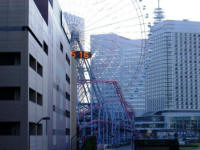 A
closer view taken at the same time. A
closer view taken at the same time.
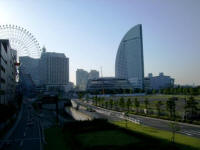 A
minute later, looking down Kokusai Odori Boulevard and showing the Hotel
Intercontinental The Grand Yokohama to the right. A
minute later, looking down Kokusai Odori Boulevard and showing the Hotel
Intercontinental The Grand Yokohama to the right.
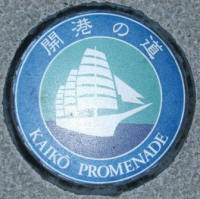 One
of the markers in the pavement of the promenade. One
of the markers in the pavement of the promenade.
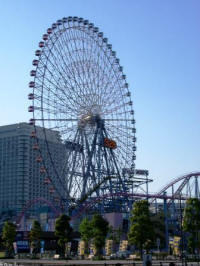 Possibly
the definitive picture of the Ferris wheel, taken at 5:29 p.m. Possibly
the definitive picture of the Ferris wheel, taken at 5:29 p.m.
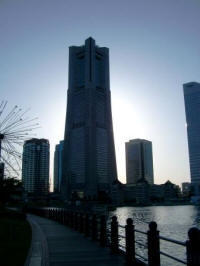 The
Yokohama Landmark Tower (at 296 meters, the tallest building in Japan), as seen from Kishamichi Promenade
(a converted railway bridge). The
Yokohama Landmark Tower (at 296 meters, the tallest building in Japan), as seen from Kishamichi Promenade
(a converted railway bridge).
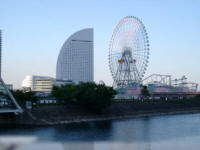 One
more try at the Ferris wheel, this time at 5:38 p.m. We have to be back at the
hotel by 6, so we’re really rushing now. One
more try at the Ferris wheel, this time at 5:38 p.m. We have to be back at the
hotel by 6, so we’re really rushing now.
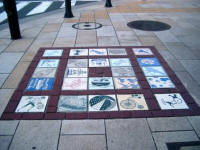 Not
in too much of a hurry, though, to seize the opportunity to photograph an
especially large collection of the varied tiles that dot the pavements
throughout this area of Yokohama. These were near the Yokohama Archives of
History. Not
in too much of a hurry, though, to seize the opportunity to photograph an
especially large collection of the varied tiles that dot the pavements
throughout this area of Yokohama. These were near the Yokohama Archives of
History.
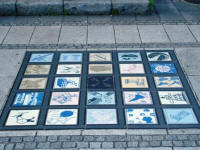 Another
assortment. Another
assortment.
East End
On the morning of Saturday, June 5, we visited Harbor View
Park, on a hill (“France-yama”) at the east end of
Yamashita Park, accessed by climbing stairs to the Yokohama Doll Museum and then
crossing “French Bridge” and climbing more stairs.
An August 2004 article by
Natasha Shieh in Yokohama Echo explains the derivation of the name of the
hill:
In Naka Ward’s Yamate area, the slopes going down
towards the Yokohama Doll Museum…make up the
area that is still today called “French Hill,” or furansu-yama. The origin
of this name comes from the long history of foreigner settlement in
Yokohama; about 130 years ago, the French military was stationed near French
Hill, while the British had its military in the area of today’s Minato-no-mieru-oka
Park/Iwasaki Museum.
The park definitely lives up to its name, providing a view
of the harbor industries and Yokohama Bay Bridge.
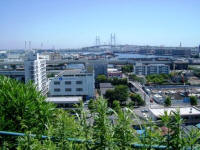
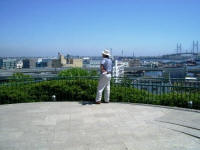
There’s a lot more to the park than
these photos show, and we wandered its trails for some time, but without taking
any other pictures. The park is the site of these notable buildings:
-
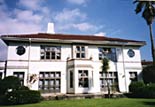 British
House Yokohama, the
former official residence for the British Consulate General in Yokohama, a
colonial-style building designed by a British engineer in Shanghai in 1937,
also designated as a tangible cultural heritage of the city of Yokohama. British
House Yokohama, the
former official residence for the British Consulate General in Yokohama, a
colonial-style building designed by a British engineer in Shanghai in 1937,
also designated as a tangible cultural heritage of the city of Yokohama.
-
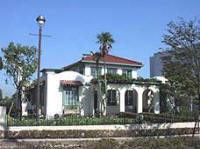 Yamate
111 Ban-Kan. Built
in 1926 as the private residence of a Mr. Laffin (an American), the mansion
was designed by J. H. Morgan, famous for his work on the spectator seats of
the Negishi Race Track, and the Yamate Seikokai Church, Yokohama. The
beautiful red-tiled and white-walled Spanish-style mansion creates an
ambience of Western housing characteristic of the colonial days, and the
vaulted ceiling and the corridor design on the second floor are unique
features in the Yamate area and exclusive to the 111 Ban-Kan. Yamate
111 Ban-Kan. Built
in 1926 as the private residence of a Mr. Laffin (an American), the mansion
was designed by J. H. Morgan, famous for his work on the spectator seats of
the Negishi Race Track, and the Yamate Seikokai Church, Yokohama. The
beautiful red-tiled and white-walled Spanish-style mansion creates an
ambience of Western housing characteristic of the colonial days, and the
vaulted ceiling and the corridor design on the second floor are unique
features in the Yamate area and exclusive to the 111 Ban-Kan.
-
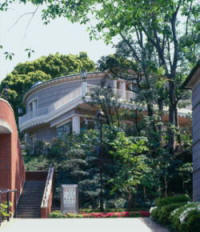 The
Kanagawa Museum of Modern Literature.
Manuscripts and letters written by novelists
and literary masters known for their connection to Kanagawa are displayed
here. The
Kanagawa Museum of Modern Literature.
Manuscripts and letters written by novelists
and literary masters known for their connection to Kanagawa are displayed
here.
-
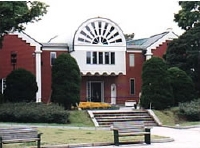 Osaragi
Jiro Memorial Museum, which celebrates the life and work of Osaragi
Jiro (1898–1973), one of the most famous writers
in post-war Japan, who was born in Yokohama and is well known for his
masterpiece Kurama Tengu. The museum houses
his manuscripts and other original works as well as a reproduction of a
study he used in his later years. Osaragi
Jiro Memorial Museum, which celebrates the life and work of Osaragi
Jiro (1898–1973), one of the most famous writers
in post-war Japan, who was born in Yokohama and is well known for his
masterpiece Kurama Tengu. The museum houses
his manuscripts and other original works as well as a reproduction of a
study he used in his later years.
We undoubtedly saw all these edifices, though without
knowing what they were.
|
